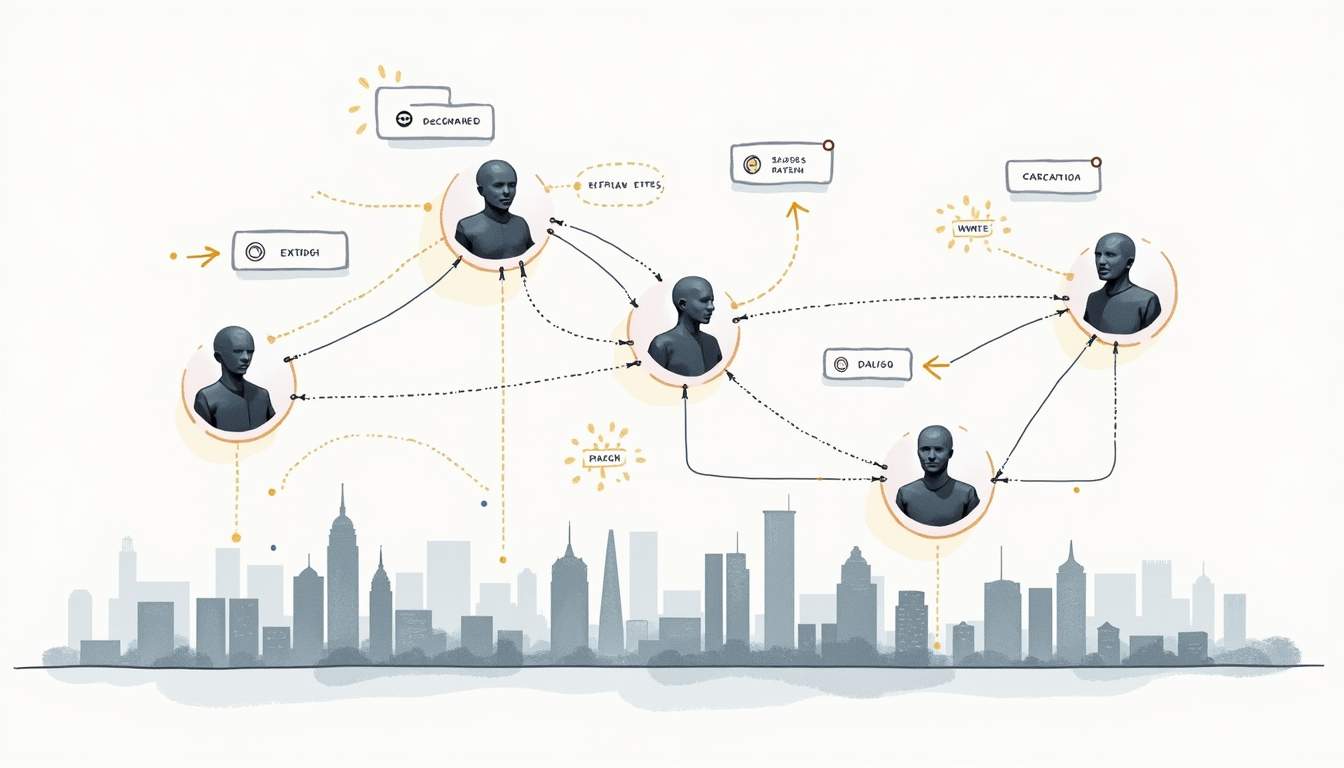Agentic AI System Architecture for Business Automation
As organizations scale automation across customer service, finance, supply chain, and knowledge work, architecting agentic AI systems becomes a strategic imperative. The architecture must balance autonomy with control, enable robust communication between purpose-built agents, and provide operational observability so business leaders can measure impact and risk. This article breaks down practical design patterns for multi-agent frameworks and explores agent communication and coordination techniques that drive reliable, high-value automation.
Multi-Agent Framework Design Patterns
Purpose-aligned agent decomposition
Divide functionality by business purpose rather than by technical layer. For example, create specialized agents for Invoice Intake, Invoice Validation, Payment Reconciliation, and Supplier Inquiry instead of a single monolithic “Accounts Payable” agent. Purpose alignment reduces complexity inside each agent, allows different agents to evolve independently, and makes it easier to attach targeted governance rules. In practice, teams see faster iteration cycles—new capabilities can be deployed for a single specialized agent without risking unrelated behavior in others.
Purpose-aligned decomposition also supports clearer KPIs. An Invoice Validation agent can be held to false positive and false negative rates, while a Supplier Inquiry agent tracks average time-to-resolution and customer satisfaction. These measurable expectations enable continuous improvement and help justify investment to stakeholders.
Layered responsibility pattern
Implement responsibilities across layers—strategic, tactical, and operational—so that higher-level agents focus on planning and orchestration while lower-level agents handle execution. A strategic Planning agent might forecast staffing needs and decide batch sizes for document processing, a tactical Workflow agent sequences tasks and hands off work, and operational Execution agents perform data extraction and API calls. This layering mirrors human organizational structures and simplifies policy enforcement: governance policies can be applied at the appropriate layer without over-constraining execution agents.
This pattern supports graceful degradation. If a planning agent temporarily underperforms due to data drift, operational agents can continue executing predefined safe modes until planning recovers, preserving essential business continuity.
Hybrid human-in-the-loop integration
Not all decisions should be fully automated. Design agents with explicit human-in-the-loop gates for high-risk or ambiguous situations. For instance, an Approval agent can escalate invoices above a certain threshold or those flagged with low confidence to a human reviewer. Build audit trails and UI components that present context succinctly so humans can intervene quickly and confidently.
Hybrid models improve system safety and stakeholder acceptance. In regulated industries such as finance and healthcare, audits and traceability are mandatory. Agents that log decision rationales, alternative options considered, and the data sources used make compliance audits feasible and reduce organizational risk.
Shared knowledge and memory management
Agents perform better with a shared, structured memory that persists facts, conversation history, decisions, and model outputs. Design a centralized semantic layer—indexed knowledge graphs or vector stores—that agents can query for context. For example, a Customer Profile agent updates a unified profile with purchase history, disputes, and sentiment. Other agents query that profile to personalize interactions and avoid repeated questioning.
Memory management must balance freshness and cost. Implement tiered retention: critical transactional records are kept long-term, ephemeral context is kept for shorter windows, and bulk raw data is archived. Periodic pruning and summarization can keep vector stores performant while retaining essential signals for decision-making.
Capability-based modularization
Abstract common capabilities—natural language understanding, entity extraction, payments API, authentication, and observability—into modular services that agents can consume. Capability modules should expose stable interfaces and versioned contracts so agents can be upgraded independently. This reduces duplication, accelerates development, and enforces consistency across agents. For example, one shared NLU module ensures consistent intent recognition across both Sales Inquiry and Support agents.
Security must be handled at the capability boundary. Modules that access sensitive data should enforce role-based access, encryption-at-rest and in-transit, and fine-grained logging. Capability-level testing and certification help ensure that any agent using the module inherits baseline security guarantees.
Resilience and fallback patterns
Design agents to fail gracefully. Common patterns include circuit breakers (temporarily stop calls to a failing external API), bulkhead isolation (limit how many agent instances can access a shared resource), and compensating actions (reverse partial work if a workflow fails mid-execution). For instance, a Payment Execution agent should have idempotence checks and reversal workflows so duplicate charges and inconsistent ledgers are avoided.
Incorporating observability—health checks, latency metrics, success/failure rates—allows automated remediation agents to restart or redirect traffic before human intervention is needed. Resilience patterns preserve customer trust and reduce operational burden as automation scales.
Governance and policy-as-code
Encode compliance, safety, and business rules as machine-readable policy artifacts that agents evaluate at runtime. These policies include data retention limits, escalation thresholds, approved vendors, and allowed financial limits. Policy-as-code makes it possible to test governance rules in CI pipelines and rapidly adjust rules to respond to regulatory changes or business needs.
Also incorporate risk scoring for automated decisions. Rather than a binary allow/deny, agents can attach a risk score to each decision and apply different workflows or human review gates depending on the score. This graded approach increases throughput for low-risk work while focusing human attention where it matters most.
Agent Communication and Coordination
Message-driven architecture and event streams
Use message buses and event streams as the backbone for inter-agent communication. Publish-subscribe patterns decouple producers from consumers, enabling horizontal scaling and loose coupling. For example, a Document Ingest agent can publish “document_received” events that downstream agents like OCR, Validation, and Routing subscribe to. Event-driven systems also support temporal decoupling, allowing agents to process events asynchronously and recover from transient failures more easily.

Event schemas should be versioned and validated to avoid silent failures. Lightweight schema registries and contract tests ensure new agent versions remain compatible with existing subscribers. Additionally, attaching metadata to events—source, timestamp, confidence—helps downstream agents make context-aware decisions.
Protocol and message semantics
Define clear communication protocols and message semantics. Standardize on message types (e.g., command, event, query), delivery guarantees (at-most-once, at-least-once), and canonical data models. Commands express intent ("charge invoice #1234"), events represent facts ("invoice #1234 charged"), and queries request state. This separation reduces ambiguity and simplifies reasoning about system state.
Use correlation IDs to trace a transaction across agents, and incorporate causal context so agents know whether a message is initiating work or responding to a prior step. Correlation IDs are invaluable for debugging and audit trails, especially in complex workflows spanning many agents.
Orchestration vs. choreography
Choose between centralized orchestration and decentralized choreography depending on business needs. Orchestration places a coordinator agent that invokes others in a defined sequence and simplifies global error handling and observability. Choreography relies on agents reacting to events to progress workflows, promoting autonomy and scalability. Many real-world systems use a hybrid: orchestration for high-risk, multi-step processes requiring strong consistency; choreography for low-coupling, high-throughput tasks.
Hybrid models often use sagas—compensating transactions implemented across agents—to manage long-running workflows without locking resources. Sagas allow partial rollbacks through compensating actions when a later step fails, which is essential for distributed financial processes and inventory adjustments.
Negotiation and coordination protocols
For multi-agent decisions where agents have partially overlapping goals (e.g., cost reduction vs. service level), implement explicit negotiation protocols. Auction-based task assignment, constraint-based solvers, or market-inspired resource allocation can resolve conflicts. For example, when multiple delivery agents compete for limited fleet capacity, a bidding mechanism can allocate tasks based on urgency, fee, and expected completion time.
Coordination protocols should include fairness and priority policies to avoid starvation of lower-priority tasks. Embedding business priorities into the negotiation process ensures alignment with organizational objectives rather than purely algorithmic optimization.
Semantic interoperability and schema mapping
Agents built by different teams or vendors often use different data schemas. Implement semantic interoperability layers—mapping services or ontology links—that translate between schemas and reconcile synonyms, units, and domain-specific codes. This reduces brittle point-to-point translations and allows new agents to join the ecosystem with less friction.
Machine-readable ontologies and shared glossaries keep business semantics consistent. For instance, aligning terms like “customer,” “client,” and “account” in a canonical model prevents costly misunderstandings in billing or legal contexts.
Latency, batching, and throughput considerations
Decide communication patterns based on latency and throughput requirements. Real-time customer-facing interactions demand low-latency synchronous calls, whereas high-throughput batch processing benefits from asynchronous streaming and bulk APIs. Batching can reduce per-request overhead, but it introduces latency and complicates failure handling—design for idempotent operations to simplify retries.
Load testing and capacity planning are critical. As agent numbers increase, contention for shared resources (databases, external APIs) can create cascading failures. Implement throttling and backpressure propagation so upstream agents slow down or reroute work when downstream capacity is saturated.
Security, privacy, and trust in inter-agent flows
Secure inter-agent communication with mutual TLS, token-based authentication, and fine-grained authorization. Encrypt sensitive payloads and apply attribute-based access controls so agents only access the minimal data needed for their task. For privacy-sensitive domains, implement differential privacy and data minimization techniques in shared memory to limit exposure of personally identifiable information.
Trust frameworks should include provenance metadata—who created or modified a message, what models or data sources influenced a decision, and which policy checks were applied. Provenance supports audits, dispute resolution, and model accountability, which become increasingly important as agent autonomy grows.
Human-agent collaboration channels
Design communication channels that integrate humans into agent workflows gracefully. Provide dashboards, alerting, and conversational UIs that surface agent state, rationale, and next actions. Humans should be able to inject corrections that agents treat as high-quality training signals or immediate overrides depending on the governance configuration.
Feedback loops are essential: capture human adjudications and use them to retrain or recalibrate agents. Closed-loop learning improves performance over time while preserving human control and institutional knowledge.
Bringing agentic AI into business automation requires thoughtful architecture around decomposition, shared capabilities, and robust communication. Applying these design patterns helps organizations scale automation safely and measurably, while maintaining agility and control. With proper governance, observability, and human collaboration, agentic systems can drive substantial efficiency gains across domains such as finance, customer service, and operations—delivering faster processes, fewer errors, and clearer accountability.






